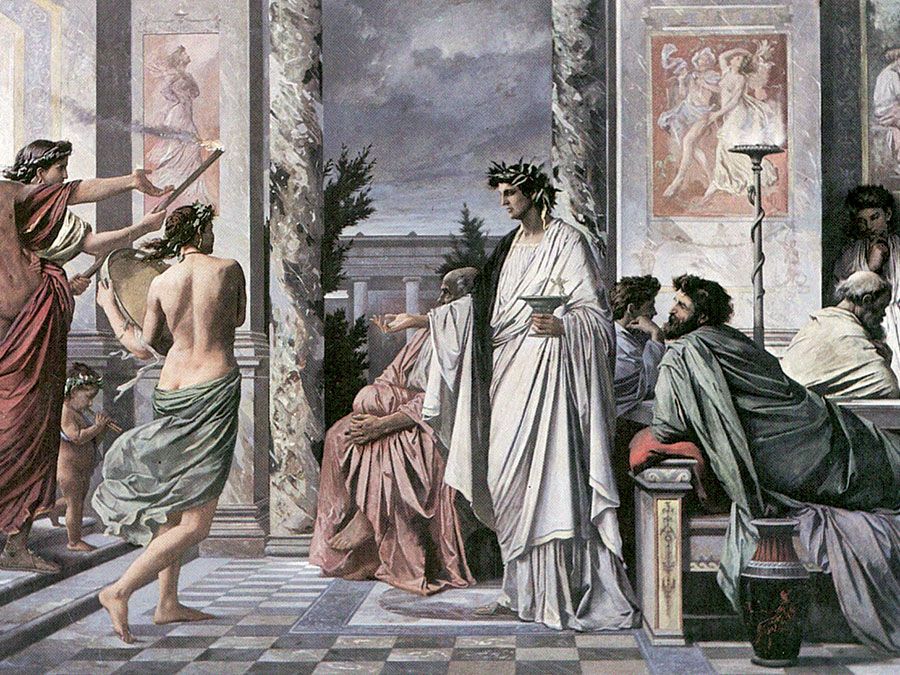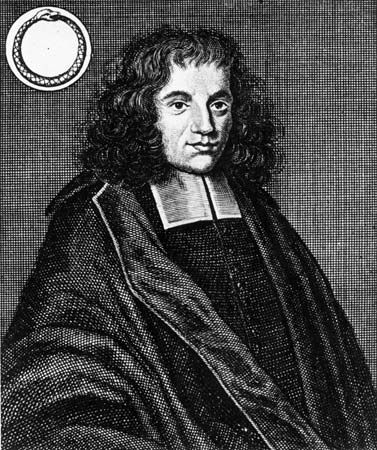Benedict de Spinoza
- Hebrew forename:
- Baruch
- Latin forename:
- Benedictus
- Portuguese:
- Bento de Espinosa
- Born:
- November 24, 1632, Amsterdam
- Died:
- February 21, 1677, The Hague (aged 44)
- Subjects Of Study:
- mind-body dualism
- pantheism
Benedict de Spinoza (born November 24, 1632, Amsterdam—died February 21, 1677, The Hague) was a Dutch Jewish philosopher, one of the foremost exponents of 17th-century Rationalism and one of the early and seminal figures of the Enlightenment. His masterwork is the treatise Ethics (1677).
Early life and career
Spinoza’s Portuguese parents were among many Jews who were forcibly converted to Christianity but continued to practice Judaism in secret (see Marranos). After being arrested, tortured, and condemned by the inquisition in Portugal, they escaped to Amsterdam, where Spinoza’s father, Michael, became an important merchant and eventually served as one of the directors of the city’s synagogue. Spinoza’s mother, Hannah, died in 1638, shortly before his sixth birthday.
The Jewish community in Amsterdam was unique in its time. It originally comprised people who had been raised in Spain, Portugal, France, or Italy as Christians and who had fled to Amsterdam to escape persecution and to practice their ancestral religion freely. The community was granted toleration by the Dutch authorities on the condition that it not cause scandal or allow any of its members to become public charges.
The community developed many social and educational institutions, including an all-male Talmud-Torah school founded in 1638. The students there were taught by adult males, many of whom had been trained at Roman Catholic schools before their arrival in Amsterdam. They taught the younger men more or less what they themselves had learned but also added instruction in various Jewish subjects, though it is not clear how much traditional Judaism was included in the curriculum. As a student in this school, the young Baruch Spinoza probably learned Hebrew and studied some Jewish philosophy, including that of Moses Maimonides.
When he was 18 or 19 years old, Spinoza and his brother went into business selling tropical fruit. At his stall on the main canal in Amsterdam, Spinoza met other young businessmen from different religious backgrounds, some of whom became his lifelong friends.

There is some evidence that Spinoza began to attract attention as a potential heretic when he was in his early 20s. After he and two other young men began teaching classes in Sabbath school, all three were charged with improprieties, though in Spinoza’s case the record of the investigation does not survive. The two other men were accused of raising doubts in their students’ minds about the historical accuracy of the Bible and about whether there might be other accounts of human history with an equal or even better claim to the truth.
In 1655 a book titled Prae-Adamitae (Latin: “Men Before Adam”), by the French courtier Isaac La Peyrère, appeared in Amsterdam. It challenged the accuracy of the Bible and insisted that the spread of human beings to all parts of the globe implies that there must have been humans before Adam and Eve. La Peyrère concluded that the Bible is the history of the Jews, not the history of humanity. Although it is not known whether Spinoza met La Peyrère at this time, one of Spinoza’s teachers, Menasseh ben Israel, was acquainted with La Peyrère and even challenged him to a debate in 1655. (Menasseh also wrote a refutation of the work, which was never printed.) Prae-Adamitae was soon condemned in the Netherlands and elsewhere, and it came to be regarded as one of the most dangerous pieces of heresy in print. Spinoza owned a copy of the work, and many of La Peyrère’s ideas about the Bible later appeared in Spinoza’s writings.
Excommunication
La Peyrère’s heresies may well have been the starting point of Spinoza’s falling out with the synagogue in Amsterdam. In the summer of 1656 he was formally excommunicated. A series of horrendous curses were cast upon him, and members of the synagogue were forbidden to have any relationship with him, to read anything he had written, or to listen to anything he had to say. The statement of excommunication, or herem (Hebrew: “anathema”), reads like a wild attack, suggesting that Spinoza was very much hated and despised. In the late 20th century it was discovered that the herem pronounced against Spinoza used a formulation that was given to the Amsterdam Jewish community by the Venetian Jewish community in 1617 and was specifically intended for heretics.
Despite the severity of the excommunication, it was apparently undertaken with some reluctance. According to Spinoza’s later account, the community offered to rescind it and even to pay him a pension if he would agree to appear at High Holiday services and to keep quiet while he was there. Spinoza apparently declined. Some time after his excommunication, he changed his given name from the Hebrew Baruch to the Latin Benedictus, both of which mean “blessed.” Despite being formally excluded from the Jewish community, he seems to have remained in contact with some members, even taking part in a Jewish theological discussion group in the late 1650s.
There is still much debate about why Spinoza was excommunicated. Many scholars have naturally tried to find an explanation in Spinoza’s religious views. Yet they have rarely taken into account the fact that the Jewish community in Amsterdam was very broad-minded and that its social and political leaders (the parnassim) were businessmen rather than rabbis. Although the Amsterdam synagogue excommunicated more than 280 people in its first century of existence, most of the cases concerned the enforcement of rules and regulations (e.g., the payment of dues and the fulfillment of marriage contracts), and only a handful involved heresy. Furthermore, although rabbis could recommend excommunication, only the parnassim could carry it out. In Spinoza’s case it is plausible to assume that the parnassim would have been most reluctant to excommunicate the son of a recently deceased parnas (Michael Spinoza died in 1654) for ideological reasons.
The American scholar Steven Nadler has contended that Spinoza’s excommunication resulted from his denial of the immortality of the soul. But Spinoza had written nothing on this subject and did not directly discuss the issue in his later philosophy. It is only by implication that it is clear that he did not believe in individual immortality. Other scholars have tried to make Spinoza’s adherence to the philosophy of René Descartes the central problem, but it is unclear that Spinoza had even studied Descartes by this time; in any event, it is unlikely that the parnassim would have been greatly exercised by the views a young man might hold about Cartesianism. Another possibility is that Spinoza was excommunicated because of his views about the interpretation of the Bible and the truth of biblical claims.
Ultimately, however, his excommunication may have had more to do with the presentation rather than the content of his beliefs. As suggested by some strongly worded sections of the Tractatus Theologico-Politicus (published anonymously in 1670), Spinoza may have been aggressively obnoxious in his criticism of established religion and insensitive to the suffering that older Marranos in the community had undergone (see below Tractatus Theologico-Politicus).
Although the herem forbade Jews to read Spinoza’s writings, there is no evidence that he had written anything other than commercial documents up to that time. Accordingly, many scholars have postulated the existence of lost heretical books. It is more likely, however, that Spinoza was still developing his own doctrines during this time. An indication of this is given in an account by an Augustinian friar of a theological discussion group attended by Spinoza in Amsterdam. He reported that Spinoza and a fellow excommunicant, Juan de Prado, held that God exists, but only “philosophically.” This statement contains the germs of the theory that Spinoza was soon to develop.
















